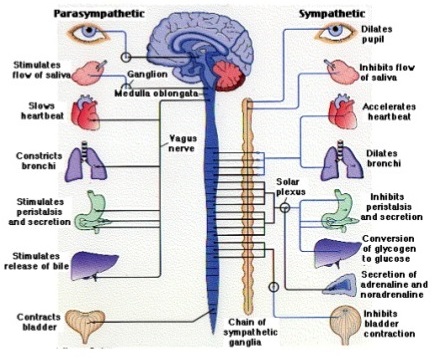How does your body respond to stressful situations? Have you ever wondered why your heart suddenly beats rapidly and you break out into a sweat when you encounter some form of danger? It's almost an automatic response that occurs whenever you sense a threat, whether it is just a potential embarrassing situation or a really scary situation such as an attack by a stranger. This fight-or-flight response is brought about by your sympathetic nervous system, which usually helps you deal with stress.
What Is the Sympathetic Nervous System?
While your brain, which is a vital part of the central nervous system, has the capability to control your conscious actions like walking, thinking and talking, your body also has an autonomic nervous system, which regulates your bodily functions, like the beating of your heart, your breathing, the way you digest your food, your sweating patterns, etc.
The autonomic system has two divisions. It consists of the sympathetic and parasympathetic nervous systems. The primary function of the sympathetic system is to stimulate your fight-or-flight response which is a physiological reaction that happens in response to a perceived harmful event, attack or threat to survival. The parasympathetic system enables you to maintain normal functions such as digesting and keeping the body at rest.
The Structure of the Sympathetic Nervous System
 Transmission of signals in the system is accomplished through a network of nerve cells called neurons. There are two types of neurons: the preganglionic neurons and the postganglionic neurons. The preganglionic neurons have short fibers that originate from the spinal cord's thoracolumbar segments, which communicate with ganglia adjacent to the spinal column, and synapse with the longer postganglionic neurons.
Transmission of signals in the system is accomplished through a network of nerve cells called neurons. There are two types of neurons: the preganglionic neurons and the postganglionic neurons. The preganglionic neurons have short fibers that originate from the spinal cord's thoracolumbar segments, which communicate with ganglia adjacent to the spinal column, and synapse with the longer postganglionic neurons.
Preganglionic neurons synapse with ganglia and release a chemical (neurotransmitter) called acetylcholine, which activates receptors on the postganglionic neurons. The postganglionic neurons in turn release a hormone called norepinephrine, which targets adrenergic receptors on various organs and tissues. Stimulation of these target receptors result in the characteristic fight-or-flight responses.
There are two exceptions to the processes mentioned above, which are the postganglionic neurons found in the sweat glands and the chromaffin cells found in the adrenal medulla. The postganglionic neurons discharge acetylcholine to activate muscarinic receptors, except for the palms, soles of the feet and other areas with thick skin. In these areas, norepinephrine acts on the adrenergic receptors. The chromaffin cells found in the adrenal medulla are equivalent to postganglionic neurons. Preganglionic neurons communicate with the chromaffin cells and stimulate them to release epinephrine and norepinephrine directly into your blood.
Two Hormones Behind the Sympathetic Nervous Activation
The sympathetic nervous system releases two hormones within the body in response to stress, resulting in an "adrenaline rush", or a sense of urgency that occurs during stressful conditions. These hormones are called epinephrine and norepinephrine, which help your body perform optimally during such events.
Upon activation of your system, norepinephrine is released to prepare the body for the initial stages of stress. If the stress is quickly resolved, the body functions return to normal. However, if the stressful event persists, your body produces epinephrine to increase these effects and activate various parts of the body to react accordingly.
What Happens If the Sympathetic Nervous Is Activated?
When one faces a dangerous or stressful situation, the sympathetic nervous system is automatically activated without conscious control. Various body functions are activated almost simultaneously such as:
- Stimulation of the adrenal glands to release norepinephrine and epinephrine, which are responsible for the cascade of reactions associated with stress.
- An increase in heart rate, which results in an increased delivery of oxygen and nutrients to the brain and the muscles to prepare them for the stress.
- An increase in glucose, released from the liver into the bloodstream to provide more energy to the muscles.
- Widening of the airways (bronchioles) in the lungs to allow more air, which increases oxygen supply to the blood and the rest of the body.
- Dilatation of the pupils, which is often observed when you are surprised or threatened.
- Slowing down of digestive activity, which helps conserve your body's energy that can be used to defend itself against stress.
- Relaxation of the bladder, which enables you to hold your urine while you are stressed. However, in worsening situations, some people involuntarily lose bladder control because of a crippling fear that allows their body to let go.
These are just some of the common functions involved in the fight-or-flight response regulated by your sympathetic nervous system. Because of such body reactions, your body is prepared to run, fight, lift heavy weights or react according to the need, depending on specific threatening situations. When the situation is resolved, the sympathetic functions return to its resting state, allowing your heart rate to go back to normal, your breathing to slow down, and your other body functions to return to a balanced state.
